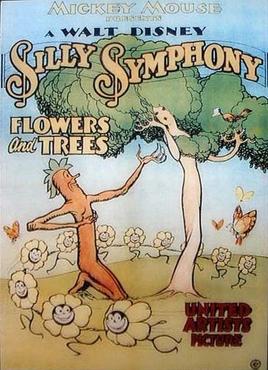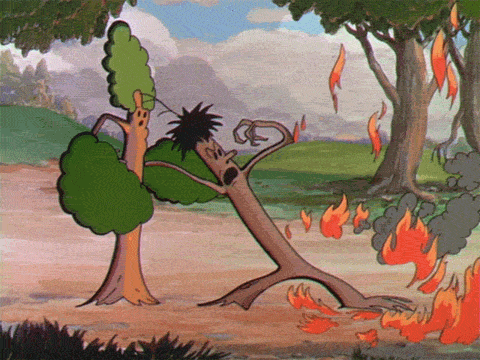A Year in Shorts Day 313: "Flowers and Trees"
The 5th Academy Awards saw the creation of the short categories at the Oscars. So far, we’ve covered a few of those inaugural nominees, including two of three first nominees for Animated Short. But we’ve yet to look at the film which won that prestigious award. Well, that changes today, with the 1932 Silly Symphony, the short which kicked off Disney's early domination of the nascent category, Burt Gillett's Flowers and Trees.
Beyond its place in Oscar history, Flowers and Trees holds a pretty important place in both Disney history and the history of cinema in general. For starters, it's important to note that Flowers and Trees is the first of the Silly Symphonies to be made in color. This was a pretty expensive proposition, especially since the short had already began production in black and white, and it was seen as something of a risk for the studio. This risk was compounded by the fact that the film wasn't using any ordinary, run-of-the-mill color process. Instead, the film would make use of the then-new three-strip Technicolor process, as opposed to the two-strip process used in previous color films. What exactly the difference between the two may be is incredibly technical and far over my head, but the long and short of it is that three-strip Technicolor was considered "full color" when compared to earlier versions. Technicolor president Herbert Kalmus wanted to test three-strip Technicolor on animation, but had trouble finding any takers. But Disney took him up on the offer, and Flowers and Trees wound up being the first commercially released film shot in three-strip Technicolor. The rest, as they say, is history.
That's all fine and good, of course, but what about the film itself? After all, it's one thing for a movie to be historically important, but that doesn't always make it any good. So what is the process of watching Flowers and Trees like? The title more or less tells you what you're in for- a movie about sentient flowers and trees going about their day, before an evil tree comes along to ruin everything. There's music and dancing and romance as one scruffy-looking dude tree tries to woo some sexy lady tree (because if there's one constant in animation, it's things which aren't typically known for fucking trying to fuck), before giving way to scenes of attempted kidnapping, dueling and widespread destruction. (This short gets strangely intense in the second half.) Flowers and Trees belongs to that old-school style of animation in which just about everything has a face or a personality, and a great deal of runtime is spent bouncing around amiably. It's the sort of cartoon they don't really make anymore, and I can't say I miss them. Even at their best, shorts like these just don't interest me that much. They just sort of wash over you, and even when they try to be funny (as this short does), the gags never really rise above the level of amusing. There are some decently clever bits of visual comedy in this short, but none of it makes me laugh, you know? If this sort of cartoon is your thing, more power to you, but I'm glad the medium has mostly evolved out of it.
But while Flowers and Trees isn't the type of short I usually go for, it's not one I hate either. There's certainly a lot to appreciate here, from the high quality animation to the way the music feels connected to the action in a way that a lot of cartoons from the time didn't have. It's certainly a damn sight better than either of its competitors. While It's Got Me Again! and Mickey's Orphans may be more in line with the type of cartoons I like, their execution left a fair bit to be desired. Flowers and Trees, on the other hand, does exactly what it sets out to do, and you have to respect that. And you also have to respect the technical innovation it represents. Disney's risk with Flowers and Trees paid off, proving the viability of three-strip Technicolor and revitalizing the Silly Symphonies series to boot. All subsequent entries in the series would be filmed using the same process, while (thanks to Disney's exclusive contract with Technicolor) rival animators would have to settle for two-strip or other inferior color processes. Let it not be said that even when taking risks, Walt Disney wasn't a shrewd businessman.
Flowers and Trees may not be the best film to win Best Animated Short, but I think its position as the first to do so was an appropriate one. The willingness to take risks and pioneer the use of new technology would define not only Disney's strategy for the rest of the decade (culminating in the release of Snow White and the Seven Dwarfs), but also a great deal of nominated shorts to follow. At its best, the category for Best Animated Short celebrates bold and astonishing accomplishments in the field of animation, rewarding those who are able to successfully match the scope of their ambition with the size of their talent. And while that's not always the case, I find that it more often than not proves to be so. As we've seen time and time again in this past year, the Best Animated Shorts rosters are often filled with daring shorts which manage to push the medium forward in new and exciting ways, both from independent creators and big studios. That creative spirit is the heart of cinema, and animation is almost always leading the charge. And Flowers and Trees proved that more often than not, the risk is well worth taking.
Keep up with the Oscar Baiting here on Letterboxd!
"Flowers and Trees" is available to watch on Disney +
The Great Oscar Baiter is a not-for-profit work of criticism. All images herein are property of their respective owners and are protected under Fair Use.




Comments
Post a Comment